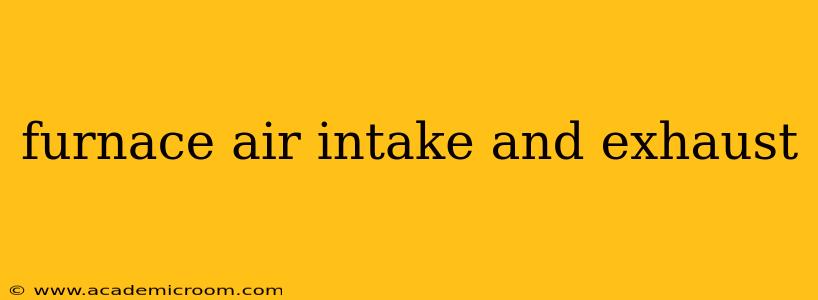Understanding your furnace's air intake and exhaust systems is crucial for safety, efficiency, and longevity. These systems work in tandem to ensure proper combustion and prevent dangerous buildup of gases. This guide will delve into the specifics of furnace air intake and exhaust, addressing common questions and concerns.
What is the purpose of a furnace air intake?
The furnace air intake supplies the combustion process with the oxygen necessary to burn fuel efficiently. Without sufficient oxygen, the furnace will struggle to ignite, produce incomplete combustion (leading to carbon monoxide buildup), and potentially damage the unit. The air intake can be directly from the room or, more commonly in modern furnaces, from outside the home through a dedicated pipe. This external intake prevents the depletion of indoor oxygen and reduces the risk of backdrafting.
How does a furnace exhaust system work?
The exhaust system safely vents the byproducts of combustion—primarily carbon monoxide, water vapor, and other gases—to the outside. This is critical to preventing dangerous concentrations of carbon monoxide from accumulating within the home. The exhaust system typically uses a vent pipe or system of pipes connected to a flue or chimney, drawing the exhaust gases upward and away from the living space. Modern high-efficiency furnaces often utilize a PVC vent pipe system, while older models might use a metal flue.
Where is the furnace air intake located?
The location of your furnace's air intake depends on the type of furnace and its installation. Older furnaces might draw air directly from the room they are located in, often through vents or openings near the unit. However, modern, high-efficiency furnaces almost always have an external air intake, drawing combustion air from outside the building through a pipe that extends through the exterior wall. This is a significantly safer and more efficient design.
Where is the furnace exhaust located?
Similar to the intake, the location of the furnace exhaust depends on the furnace type and installation. The exhaust vent usually leads to the exterior of the home, often through the roof or the side wall. It's crucial to ensure this vent remains unobstructed to maintain proper airflow and prevent dangerous gas buildup inside. You'll often see a vent pipe or terminal extending outside, sometimes with a cap to prevent the entry of debris.
What happens if my furnace air intake is blocked?
A blocked air intake severely restricts the oxygen supply to the furnace. This can lead to incomplete combustion, reduced heating efficiency, and the production of dangerous levels of carbon monoxide. Symptoms might include a yellow or orange flame (instead of a blue flame, indicating incomplete combustion), a decrease in heating output, and a build-up of soot. In severe cases, the furnace could shut down due to safety mechanisms or suffer damage.
What happens if my furnace exhaust is blocked?
A blocked exhaust system is even more dangerous than a blocked intake. The exhaust gases, including deadly carbon monoxide, will back up into your home. This can lead to carbon monoxide poisoning, a serious and potentially fatal condition. Symptoms include headaches, dizziness, nausea, and weakness. A blocked exhaust is a critical safety issue requiring immediate professional attention.
How often should I have my furnace air intake and exhaust checked?
Regular maintenance is crucial for the safe and efficient operation of your furnace. It's recommended that you have a qualified HVAC technician inspect and clean your furnace's air intake and exhaust system annually as part of your regular furnace maintenance. This will ensure proper airflow, identify any potential blockages, and prevent safety hazards.
This guide provides a general overview; always consult a qualified HVAC technician for specific advice regarding your furnace and its safety. Ignoring proper maintenance of your furnace's air intake and exhaust can lead to serious safety risks and costly repairs.
